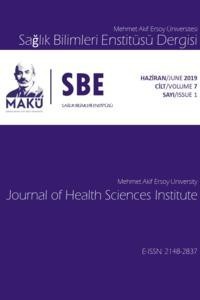Van Bölgesindeki Bal Arılarında (Apis mellifera) Bulunan Varroa destructor’un (AKAR: Varroidae) Genetik Karakterizasyonu
Haplotip, Van, Varroa destructor
___
- Akinwande KL, Badejo MA, Ogbogu SS. 2012. Incidence of the Korean haplotype of Varroa destructor in southwest Nigeria. J Apic Res. 51(4): 369-370. Anderson D, Trueman JWH. 2000. Varroa jacobsoni (Acari: Varroidae) is more than one species. Exp. Appl. Acarol. 24: 165-189. Anderson DL, Fuchs S. 1998. Two genetically distinct populations of Varroa jacobsoni with contrasting reproductive abilities on Apis mellifera. J. Apic. Res. 37(2): 69-78. Aydın L, Güleğen E, Çakmak İ, Girişgin AO. 2007. The Occurrence of Varroa destructor Anderson and Trueman, 2000 on honey bees (Apis mellifera) in Turkey. Turk. J. Vet. Anim. Sci. 31: 189-191. Beaurepaire AL, Truong TA, Fajardo AC, ve ark. 2015. Host Specificity in the Honeybee Parasitic Mite, Varroa spp. in Apis mellifera and Apis cerana. PLoS ONE. 10(8): 1-12. Chemurot M, Akol AM, Masembe C, ve ark. 2016. Factors influencing the prevalence and infestation levels of Varroa destructor in honeybee colonies in two highland agro-ecological zones of Uganda. Exp. Appl. Acarol. 68(4): 497-508. Crane E. 1978. The Varroa mite. Bee World. 59: 164-167. De Guzman LI, Rinderer TE, Stelzer JA. 1999. Occurrence of two genotypes of Varroa jacobsoni Oud. In North America. Apidologie. 30: 31-36. De Jong D, Gonçalves LS. 1981. The Varroa problem in Brazil. Am. Bee. J. 121: 186-189. Delaplane KS. Varroa destructor: revolution in the making. Bee World 2001; 82(4): 157-159. Gajic B, Radulovic Z, Stevanovic J, ve ark. 2013. Variability of the honey bee mite Varroa destructor in Serbia, based on mtDNA analysis. Exp. Appl. Acarol. 61: 97-105. Maggi M, Medici S, Quintana S, ve ark. 2012. Genetic structure of Varroa destructor populations infesting Apis mellifera colonies in Argentina. Exp. Appl. Acarol. 56: 309-318. Muñoz I, Garrido-Bailón E, Martín-Hernández R, ve ark. 2008. Genetic profile of Varroa destructor infesting Apis mellifera iberiensis colonies. J. Apic. Res. 47: 310-313. Navajas M, Anderson DL, De Guzman LI, ve ark. 2010. New Asian types of Varroa destructor. a potential new threat for World apiculture Apidologie. 41: 181-193. Rosenkranz P, Aumeier P, Ziegelmann B. 2010. Biology and control of Varroa destructor. J. Invertebr. Pathol. 103: 96-119. Sakai T, Okada I. 1973. The present beekeeping in Japan. Glean Bee Cult. 101: 356-357. Strapazzon R, Carneiro FE, Guerra Jr JCV, ve ark. 2009. Genetic characterization of the mite Varroa destructor (Acari: Varroidae) collected from honey bees Apis mellifera (Hymenoptera, Apidae) in the State of Santa Catarina, Brazil. Genet. Mol. Res. 8(3): 990-997. Thompson HM, Brown MA, Ball RF, ve ark. 2002. First report of Varroa destructor resistance to pyrethroids in the UK. Apidologie. 33: 357-366. Warrit N, Hagen TAR, Smith DR, ve ark. 2004. Survey of Varroa destructor strains on Apis mellifera in Turkey. J. Apic. Res. 43(4): 190-191. Webster TC, Delaplane KS. 2001. Mites of Honey Bee, İllinois,:Dadant ve Sons Yayıncılık, s. 280.
- ISSN: 2148-2837
- Yayın Aralığı: Yılda 3 Sayı
- Başlangıç: 2013
- Yayıncı: Burdur Mehmet Akif Ersoy Üniversitesi
Pınar ARCA, Zülfükar Kadir SARITAŞ
BVD ve BHV-1 ile tek ve çift infeksiyonlarda bazı akut faz proteinleri ve hepcidin düzeyleri
Şima ŞAHİNDURAN, Mehmet KALE, Reyda KIYICI
Mehmet ÖZBEK, Mustafa HİTİT, Emel ERGÜN, Feyzullah BEYAZ, Levent ERGÜN
IL-6 İlavesi HEPG2 Hücrelerinde Kaspaz Aktivitelerini Nasıl Etkiler?
Burcu Menekşe BALKAN, Görkem KISMALI, Deniz TURAN, Ali Burak BALKAN, Tevhide SEL
Adnan Ayan, Kerem URAL, Osman Selçuk ALDEMİR, Hidayet TUTUN
Filamentöz faj üzerinde eksperese edilen Hepatit B yüzey antijenine karşı antikor yanıtı
Aynur BAŞALP, İbrahim HATİPOĞLU, Bertan Koray BALCIOĞLU, İbrahim SÖĞÜT, Aylin ÖZDEMİR BAHADİR, Kamil Serkan UZYOL, Hülya SİVAS, Berrin ERDAĞ
Memeli hücrelerinde otofajinin moleküler mekanizması
Yasemin SAHIN, Dilara AKCORA YILDIZ
Fare Blastosistlerinde Hücre Kaderinin Belirlenmesi
Cennet Sinem Çoban, Duygu Mutluay
Veteriner İlaç Alanında Rekombinant DNA Teknolojisinin Kullanımı
Levent ALTINTAŞ, Hakan ENVER, Hidayet TUTUN
